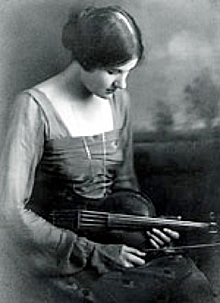Rebecca Clarke (1886 – 1979)
Rebecca Clarke was born in Harrow, England to an American father and German mother. Her father was a tyrannical music lover, for he forced all his children to learn instruments so they could play chamber music for him. That’s how Rebecca learned violin.
In 1903, Rebecca Clarke continued her studies at the Royal Academy of Music, but then transferred to the Royal College of Music after a professor proposed to her. On the advice of another professor, she switched from the violin to the viola because being in the middle of the strings would give her a better sense of orchestral structure.

In 1910, she began supporting herself by playing the viola as a soloist, and with chamber ensembles and orchestras. She made her first visit to the United States in 1916, and played one of her first mature compositions, Morpheus for viola and piano, in several venues including Carnegie Hall:
In a famous incident in 1919, she entered her Viola Sonata in a contest, and came in second, but the name “Rebecca Clarke” was widely assumed to be a pseudonym, for it was believed that no woman could compose as well as that.
Rebecca Clarke was in the United States at the outset of World War II and couldn’t return to England, so she settled in the US, eventually living in New York City. She encountered an old college friend on the streets on Manhattan and married him in 1942. She stopped composing at about the same time and died in New York City at the age of 93.
Here is Rebecca Clarke’s impressionistic Debussyan Viola Sonata: